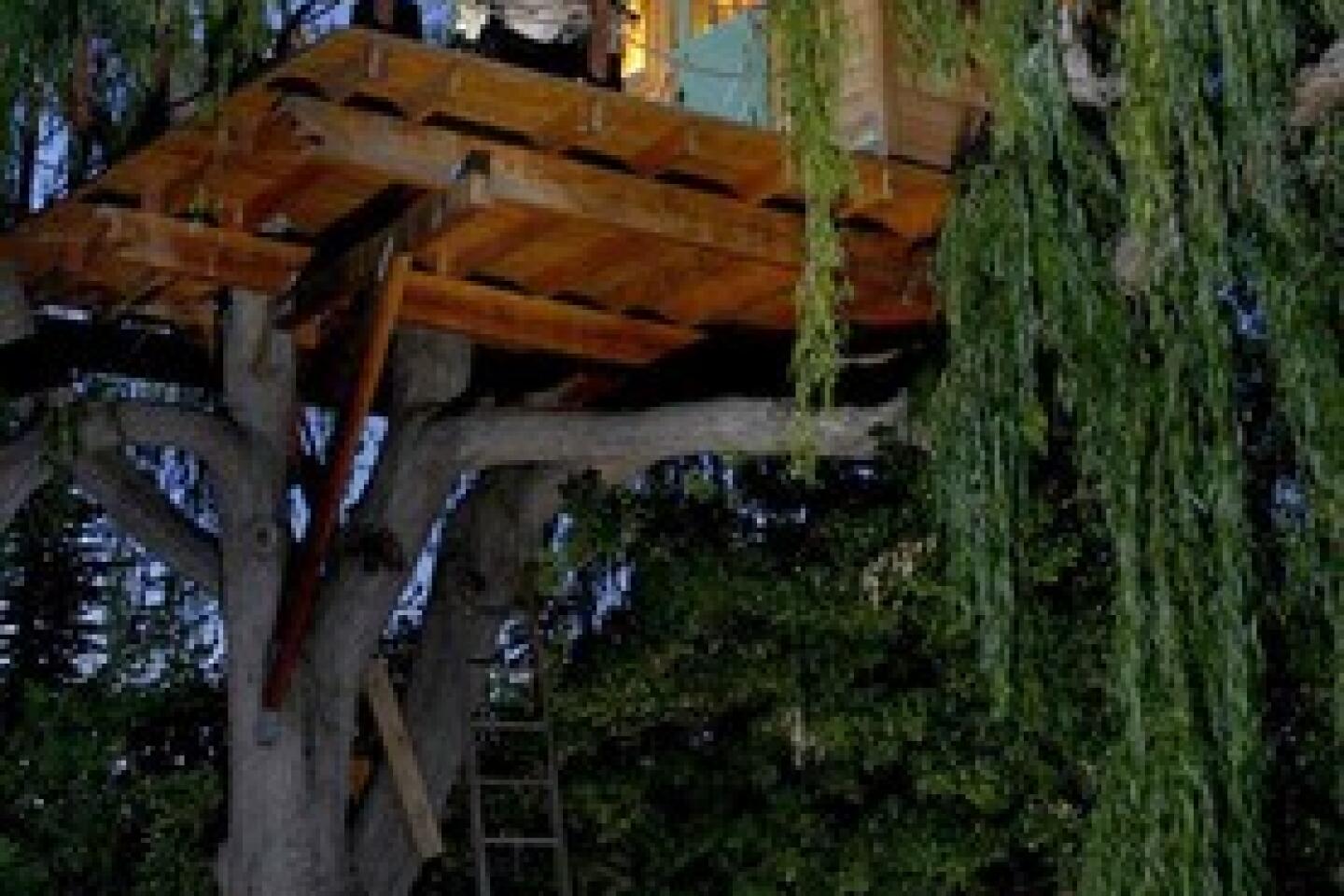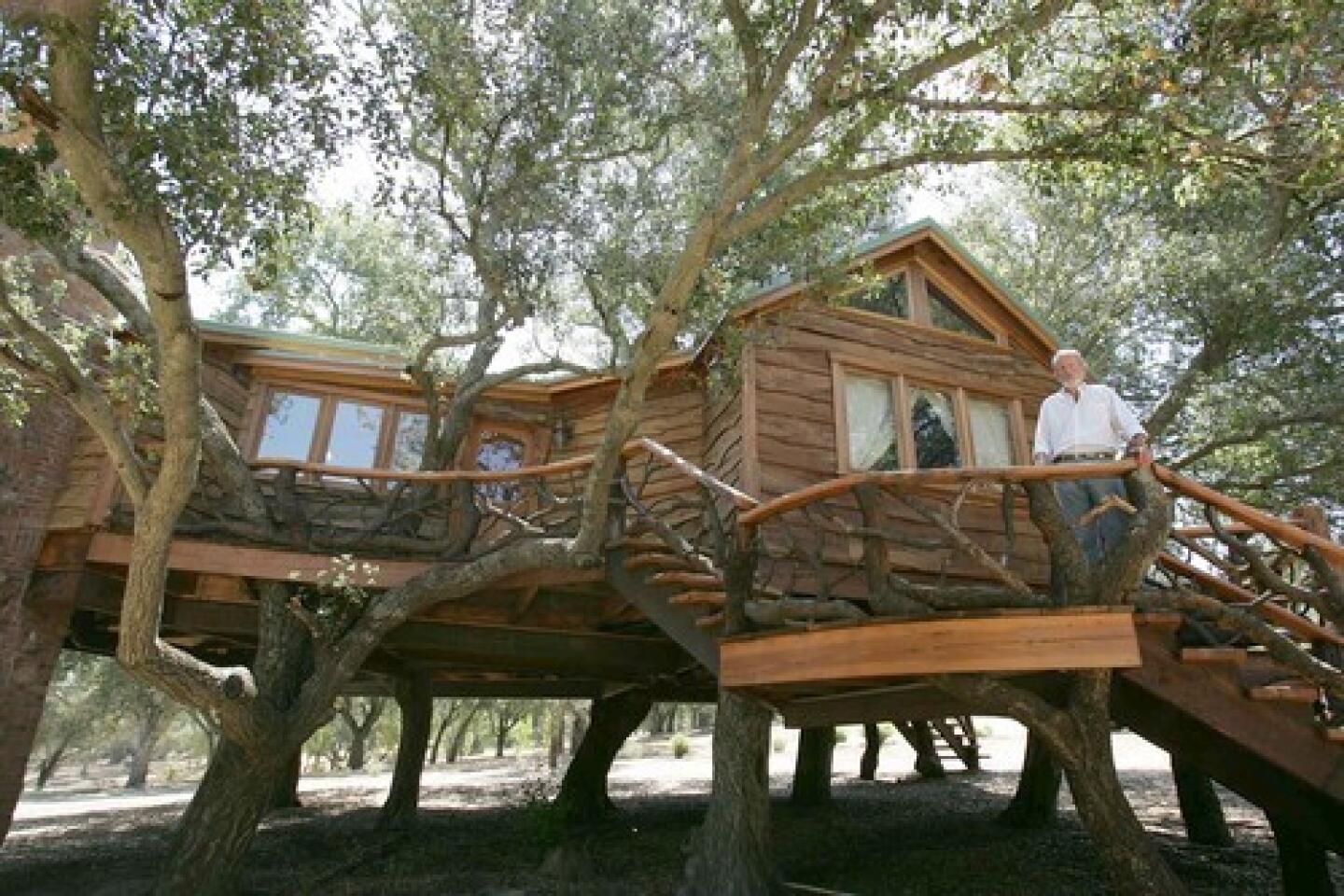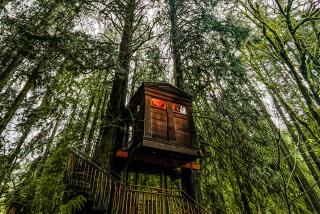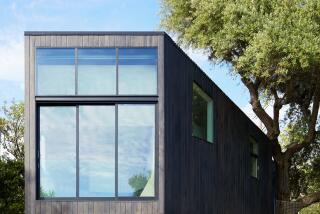Dreamhouse in the trees
- Share via
By Steven Barrie-Anthony, Times Staff Writer
It usually starts as a joke. Even you think you’re kidding, at first. A treehouse? Grow up. But then fantasy overwhelms your rational instincts, bit by bit. “Doesn’t everyone want a treehouse?” Kit Sickels asks. That’s a common assumption among adult treehouse owners, who often have trouble pinpointing the exact nature of their fascination. “You’ll know what I mean when you visit,” they say.
Sickels, a San Diego real estate developer, and his wife, Karen, a retired schoolteacher, started talking treehouses while vacationing in Colorado. They followed their whim to an Aspen bookstore, where they bought two books by treehouse maven Peter Nelson.
Nelson’s Seattle-based company TreeHouse Workshop has built more than 60 treehouses in the last six years, many of them for adults. The world’s largest treehouse builder, Scotland-based TreeHouse Co., fields “far more enquiries from the States than from all other countries combined,” says president John Harris, whose company will build more than 150 treehouses this year, up from 40 in 2000 and three in 1996.
In the past five years, home offices, libraries, guest rooms, even entire houses have increasingly begun migrating skyward, aided by a tightknit cadre of treehouse architects, carpenters, arborists and engineers who build treehouses full time.
Buoyed by the realization that plenty of perfectly sane people choose to spend time in the trees, the Sickelses arranged to meet Nelson in Seattle. In the weeks following, Nelson drew up a plan and a 32-year-old carpenter named Bubba Smith rigged himself a temporary home in a tree on the Sickelses’ 70-plus acres in northeastern San Diego County. In June of last year, construction began on what would become one of the few full-amenity treehouses in the country.
For the central figure in the American treehouse movement, it all began 34 years ago in front of a tiny Dutch colonial house in Ridgewood, N.J. Eight-year-old Nelson -- a lanky, blond, would-be hippie wearing colorful bell-bottoms -- grabbed a hammer and began nailing two-by-fours into a nearby maple. First he built a ladder, then a platform sprouted in the elbow of the split-trunk tree, then a roof.
Over the next eight years, Nelson and his tomboy kid sister divided their time between trees and the ground. About the time he got his “driver’s license and discovered the opposite sex,” his arboreal gene went into “deep freeze,” he says, but it resurfaced when he was 25 and working in Colorado as a carpenter.
“I imagined that there were some adult-size treehouses out there,” says Nelson, who began photographing any he could find. To gain access, he told people he was working on a coffee-table book. “Treehouses: The Art and Craft of Living Out on a Limb,” was published in 1994 -- and still sells.
While swinging through palms in Hawaii, Nelson heard of a guy in Oregon who had just built his first treehouse -- so he flew to Portland and drove to “the middle of nowhere” to Takilma, a former copper-mining town. There he met Michael Garnier, a man with an imposing French fur trapper mustache who had opened a bed-and-breakfast hundreds of miles from any potential guests.
“I started a bed-and-breakfast with a cabin, but nobody came,” says Garnier, who decided to fulfill a fantasy that had taken ahold of him as he pounded an impromptu treehouse for his kids -- hoping that with luck, it would jump-start his business. He eyed a sturdy redwood and grabbed his toolbox. “I was going to make the treehouse that I always wanted,” he says.
Word spread about a treehouse bed-and-breakfast, and in the early 1990s people such as Nelson started arriving -- people who say they are busy indulging their childhood dreams.
There was Charlie Greenwood, a former Silicon Valley engineer, and Jonathan Fairoaks, certified arborist. These men and others formed the nucleus of the American treehouse movement, and for the past eight years they have returned to Takilma each Columbus Day weekend to participate in the World Treehouse Assn. Conference.
Conference attendance has grown to about 60 and includes enthusiasts from Japan and Europe who seek workshops on treehouse design or engineering. Each year they toast breakthroughs such as the Garnier limb, an artificial branch that minimizes puncture damage to the tree while providing an anchor that can hold up to 9,000 pounds.
Today, Garnier’s Out’n’About Treesort features 18 treehouses up to 37 feet in the air, connected by swaying rope bridges and treetop platforms. Families can opt for the Suite -- replete with queen bed, loft, dining table and antique claw-foot bathtub -- or Treezebo, a gazebo-style pad nearly 40 feet above ground. To get to Treezebo, follow the Mountain View Treeway: a spiral staircase and 135 feet of suspension bridges.
It’s a veritable city in the trees -- bed-and-breakfast, plus Treehouse Institute, where visitors with arboreal inclinations enroll in courses from Treeminology to Treehouse Construction 301.
The team goes to work
By the time Smith is sleeping in one of your trees, you’ll realize, as the Sickelses did, that building a treehouse is no longer a summer afternoon filled with lemonade, two-by-fours and rusty nails. Three forces are at work here: you, the planners and carpenters, and the tree. And the tree, say treehouse builders, is always in charge.
Enter the arborist, who will stage an elaborate dance, kneeling to gauge soil quality, prodding and measuring roots and branches to get a feeling for the site. Enter the engineer, who will “assess the critical geometry of the tree or trees,” explains Greenwood. Measure base dimensions. Taper. Wind mass. Sail area. Watch Greenwood plug data into the same computer software used to design the International Space Station.
Nelson patiently draws and redraws, Smith and another carpenter spend the next nine months hammering, and the Sickelses learn to go with the flow. For lumber, the team fells standing dead oaks on the property, and Nelson ships beautiful refurbished wood from old demolished buildings in Seattle. A brick fireplace? Skylights? Let’s give it a shot! Finally: plumbing, electricity, heat and air conditioning. In the end, the house is 980 square feet, 10 feet off the ground.
Kit Sickels “got writer’s cramp from signing checks” -- around $350,000 worth -- but few treehouses are so elaborate and expensive. Most treehouse owners willingly sacrifice the practical for the fantastical -- why bother with a/c and plumbing when you can be like Andrew Fisher and build 40 feet in the air and install a zip line that zooms you directly to a homemade archery range?
Fisher, a San Francisco interior decorator, is a Napa-based Tarzan come weekends. He followed the whim, got the books, but Nelson was too busy to call back. So Fisher phoned Jonathan Fairoaks and soon the arborist was in Napa, climbing and examining bark. About four months later, in July 2002, Fairoaks and a crew of two put the finishing touches on a 400-square-foot room high in the swaying pines.
“I wanted it to gray out to nothing and fade right into the trees,” says Fisher, and unless you’re looking for it you’re liable to miss this guesthouse and weekend hideaway ensconced in the boughs above. The end of construction was only the beginning for Fisher, who built “make-believe furniture” -- such as an oversize “fantasy Indian daybed” -- and upholstered the walls in gold lame. He installed a gilded steel chandelier fashioned to resemble tree branches sprouting from the ceiling and mounted jasmine-filled planter boxes outside.
Treehouses “are just inherently dreamlike,” says Fisher. He and his partner host cocktail parties, and sometimes offer the room to newlyweds who “find it extremely romantic.” All’s well until windstorms kick up and buffet the treehouse 2 feet from side to side: time to descend -- or all part of the adventure, depending on your perspective.
Then there are the unwearied do-it-yourselfers. Inspired by a treehouse photo in Smithsonian magazine, Pasadena magician Mike Caveney scaled the giant willow in his backyard and “basically never came down.” In 1997, he donned a mountain climber’s harness, anchored himself to the trunk, and built a platform 18 feet up. Next, he spent two years in the garage fashioning redwood walls and a shingled roof. “I went as slowly as I could,” Caveney admits. “I didn’t want this to end.”
When Caveney emerged, he and wife Tina Lenert, also a magician, staged a “treehouse raising” party. Friends and neighbors cheered as Caveney used a pulley system to hoist each piece into place. The Craftsman-style treehouse took less than an hour to assemble. Solar panels on the roof generate enough electricity to power reading lights and a small TV. Even so, Caveney and Lenert often find themselves just ... sitting. Sometimes for hours.
Far from the ground, sheltered by fluttering willow fronds, the mind slows and turns inward. “Decisions get made up here,” Lenert says. New magic tricks bubble from the deep.
An ancient inclination
Treehouse living reaches back to ancient times, says Harris, a self-appointed historian of the treehouse movement who enjoys putting this “treehouse revival” in context. Long ago, “humans used to live in trees,” he says. “It was the most hygienic way to live.” Eventually people descended, but throughout history they have built in the boughs again and again. In 16th and 17th century Europe, for instance, “any well-to-do person had a treehouse,” he says. “They were the places that the landed gentry took their girlfriends.”
Winston Churchill had a treehouse at Chartwell Manor, his country estate in Kent, England, as did John Lennon during his first years as a Beatle. Chances are, though, that they never had to deal with what Garnier calls “Legalitrees” -- the, “Hey, you up there in the tree! That thing isn’t up to code.”
“One grouch can take all the wonderment and fantasy away,” says Jeri Chiavetta, a Huntington Beach grandmother who in 2000 was forced to remove her Greene and Greene-style treehouse after a neighbor complained. Few cities have specific treehouse zoning regulations, so negative attention can be a death knell. Locals rallied with petitions and “Save the Treehouse!” signs, to no avail. Greenwood, the engineer, is working on a model treehouse code that may someday, he hopes, be adopted by city governments.
Until then, make friends with neighbors. Invite them skyward. Once people leave the ground, say treehouse owners, they are more likely to build their own hideaway than to nix yours.
*What about the tree?
Treehouses can bring a hidden benefit to their living hosts by extending the lifespan of the tree, if the structures are installed properly. They can, for instance, make it more stable by lowering the tree’s center of gravity and strengthen weak branch structures.
“Let the tree design the treehouse,” says Jonathan Fairoaks, an arborist and treehouse builder who considers trees “very intelligent.... Their chemical makeup allows them to adapt to new stresses.”
To cut down or eliminate damage to the tree, hire an arborist before picking up a hammer, major treehouse builders say, and follow this advice:
* Build below the tree’s center of gravity.
* If possible, let two or three trees share the load.
* Puncture the tree as infrequently as possible, and drill holes at a distance from one another so that wounds don’t coalesce.
* Use bolts and hardware designed for treehouses -- this way, the “tree actually grows over the bolts, and connections grow stronger over time,” Fairoaks says. Nails will be slowly expelled.
More to Read
Sign up for The Wild
We’ll help you find the best places to hike, bike and run, as well as the perfect silent spots for meditation and yoga.
You may occasionally receive promotional content from the Los Angeles Times.













